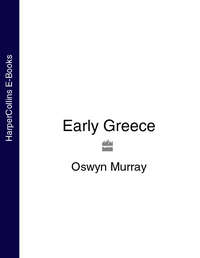
Полная версия
Early Greece
The Lelantine War marked the end of an era in another way. It was the last war fought in the old style between the leading proponents of that style; an early oracle ran:
Best of all land is Pelasgian Argos,
the horses of Thessaly, the women of Sparta,
and the men who drink the water of holy Arethusa (in Chalcis)
(Palatine Anthology 14.73)
Strabo, who mentions this poem, claims also that Eretria controlied Andros, Teos, Ceos and other islands; and he records an inscription from the shrine of Artemis Amarynthios near Eretria which mentioned a procession of 3000 infantry, 600 horsemen and 60 chariots (Strabo 10.448) – a large force for such a city, and an impressive display of horsepower. The aristocracy of Chalcis was called the ‘horse-rearers’ (hippobotai), and ancient descriptions of the fighting emphasize the importance of ‘cavalry’ (that is probably aristocratic mounted infantry); it was in fact a gentleman’s war, for another inscription in the shrine of Artemis recorded an agreement ‘not to use long distance missiles’, that is the stones and arrows of the lower classes. The style of fighting was perhaps remembered in the next generation, for despite the future tenses Archilochos seems to look back in saying:
No bows will be stretched in numbers, nor slings in multitudes, when Ares joins the struggle in the plain; but it will be the dour work of swords, for this is the style of battle that they are masters of, the spear-famed lords of Euboea.
(Archilochos Fragment 3)
It was a truly epic war. One by one the champions fell; Kleomachos the Thessalian was commemorated with a pillar in the gathering place of Chalcis; the funeral of Amphidamas champion of Chalcis was celebrated with heroic contests modelled on those in epic, at which Hesiod won his prize (Works and Days 654–7). And on the other side excavations at Eretria have revealed by the West Gate looking towards the road to the Lelantine Plain a shrine with many seventh century offerings and sacrifices over a group of six warrior cremations from the period 720–680; the central and earliest one was of a noble buried with four iron swords, five spearheads of iron and one of bronze (a Mycenean heirloom, perhaps serving as his skēptron), and a handsome Phoenician scarab in a gold setting – a basileus of Eretria who (like Glaucus and Sarpedon in the Iliad) was with his companions especially honoured during his life and looked on as a god after his death.
How long the war lasted is uncertain, as is its outcome. The Chalcidians won one battle with Thessalian help, but the archaeological evidence from Eretria suggests that it suffered no major setback. Lefkandi was finally abandoned; but that is not surprising, for it stands half way between Chalcis and Eretria on the edge of the disputed Lelantine Plain, which geographically belongs to Chalcis. At Al Mina Euboean interest virtually disappears; after the break around 700, the pottery from the period 700–600 is largely Corinthian (perhaps carried by Aeginetans, who produced no pottery of their own) and east Greek, from such centres as Rhodes, Samos, Chios and (probably) Miletus. It seems that as usual neither protagonist in the war benefited: exhausted by the conflict, they were never again politically important. The rewards of their exploits overseas and the leadership in Greece passed to others; the old oracle was continued to fit a new generation:
….But better still than these are they who dwell between Tiryns and Arcadia rich in sheep, the linen-corseleted Argives, goads of war.
Конец ознакомительного фрагмента.
Текст предоставлен ООО «ЛитРес».
Прочитайте эту книгу целиком, купив полную легальную версию на ЛитРес.
Безопасно оплатить книгу можно банковской картой Visa, MasterCard, Maestro, со счета мобильного телефона, с платежного терминала, в салоне МТС или Связной, через PayPal, WebMoney, Яндекс.Деньги, QIWI Кошелек, бонусными картами или другим удобным Вам способом.


